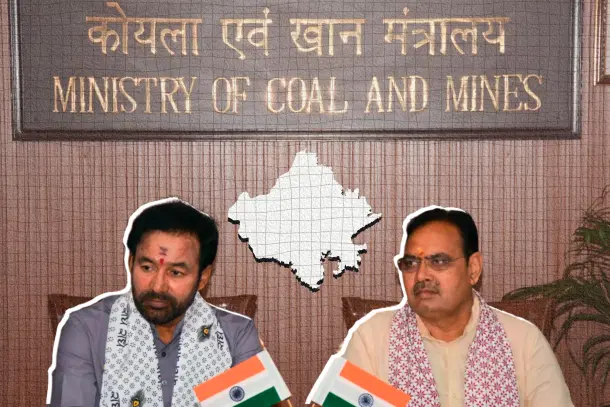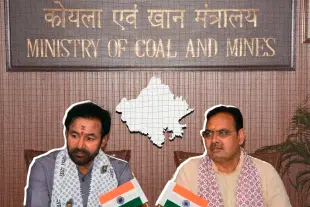States
How A Change In Government Revitalised Rajasthan's Mining Sector
Nishtha Anushree
Jul 23, 2025, 09:44 AM | Updated 09:44 AM IST
Save & read from anywhere!
Bookmark stories for easy access on any device or the Swarajya app.


When the Bharatiya Janata Party (BJP) government assumed office in Rajasthan in December 2023, the state's mining sector was languishing despite sitting atop some of India's richest mineral deposits.
The previous five years had seen only 34 mineral block auctions, while critical resources like potash—comprising over 95 per cent of India's reserves—remained entirely untapped. Within months of the political transition, this scenario would change dramatically.
The transformation began almost immediately. Between February 2024 and January 2025, the new administration conducted 49 major mineral block auctions—nearly 50 per cent more blocks in one year than the previous government had managed in five.
Mining revenue surged 24 per cent from Rs 7,460 crore in 2023-24 to Rs 9,228 crore in 2024-25, with ambitious targets set for Rs 12,950 crore in 2025-26.
This remarkable turnaround reflects how political will and administrative focus can unlock economic potential that had remained dormant for years.
The Starting Point: The Underperforming Assets
Before December 2023, Rajasthan's mining sector exemplified missed opportunities. Despite being among India's top three mineral-producing states alongside Odisha and Chhattisgarh, the state operated well below its geological potential.
Mining contributed just 3.4 per cent to Rajasthan's Gross State Domestic Product (GSDP), a figure that analysts considered inadequate given the state's mineral endowments.
The challenges were systemic. Exploration proceeded slowly due to dependence on under-resourced agencies. Administrative and judicial hurdles kept promising areas unused.
Complex bidding and permitting processes deterred investors. Most critically, there appeared to be insufficient political prioritisation of the sector's development.
Critical minerals remained particularly neglected. India imported over Rs 8,000 crore worth of potash in 2024-25 alone, despite Rajasthan holding the vast majority of the country's reserves.
Rare earth minerals, essential for modern technology and defense applications, lay largely unexplored despite global supply chain vulnerabilities and China's 90 per cent dominance in production.
Administrative Restructuring: Setting New Priorities
The incoming government signaled its commitment to the mining sector transformation through key administrative decisions. Chief Minister Bhajan Lal Sharma retained the mines and petroleum portfolio personally, demonstrating the sector's elevated importance. Shortly after taking office, he appointed T Ravikanth, a trusted officer, as Principal Secretary to the department.
These personnel decisions reflected a broader shift in approach. The new administration moved quickly to accelerate pending processes and remove bottlenecks that had constrained sector development. The focus extended beyond traditional revenue generation to strategic objectives like reducing import dependence and positioning Rajasthan as a national mining hub.
This administrative restructuring created momentum that would drive subsequent developments. Officials received clear mandates to expedite processes, resolve pending issues, and maximise the state's mineral potential.
Breakthrough Moments: Critical Minerals Take Off
The government's new approach yielded its first major success in May 2025 with successful e-auctions for two potash and halite blocks in Hanumangarh district.
Hindustan Zinc Limited (HZL) and Oil India Limited emerged as preferred bidders, with HZL receiving its Letter of Intent for operations covering over 1,800 hectares. This marked India's first venture into domestic potash production.
Union Mining Minister G Kishan Reddy emphasised the strategic significance, stating that unlocking potash mining potential would reduce import dependency and support farmers—the backbone of agriculture. The development represented more than revenue generation; it addressed national food security and foreign exchange conservation.
Rare earth minerals provided another breakthrough. The government's proactive approach enabled the identification of significant reserves in Bhati Kheda, located in Siwana tehsil of Balotra.
Following surveys by the Geological Survey of India (GSI) and Atomic Minerals Directorate (AMD), these reserves are now slated for auction with an expected valuation of Rs 10 crore.
This development proved particularly timely given global supply chain vulnerabilities. India, despite holding the world's third-largest rare earth reserves at 6.9 million tonnes, contributed less than 1 per cent to global production due to limited processing infrastructure. The new administration's focus on these critical materials aligned state priorities with national strategic objectives.
Accelerating Momentum: Record Auction Activity
The government's emphasis on sector development translated into unprecedented auction activity. In 2024, Rajasthan became the leading state in India for mineral block auctions, earning national recognition with first prize at the National Mines Ministers' Conference.
This momentum continued into 2025, with 34 major mineral block e-auctions launched and nine completed by 2 July. The auction portfolio reflected comprehensive sector development: half the blocks targeted limestone for cement production, while 16 composite license blocks included critical minerals like copper.
Deepak Tanwar, Director of the Department of Mines and Geology, highlighted the scale of transformation: "Over 20 per cent of India's auctioned mines are in Rajasthan. Out of 500 mines auctioned nationally, 106 are in Rajasthan. While many are operational, some are awaiting mining plan approval from IBM (Indian Bureau of Mines), while others require different clearances."
The copper focus proved strategically important given India's heavy import dependence and Rajasthan's possession of more than half the country's reserves. Most auctioned copper blocks were located in the Bhilwara district, positioning the state to contribute significantly to national self-reliance objectives.
Policy Framework: Institutionalising Change
Recognising the need to institutionalise its approach, the government released the Rajasthan Mineral Policy 2024 in September. Rather than initiating change, the policy codified and expanded upon momentum already generated through administrative action.
The policy set ambitious long-term goals: doubling mining's contribution to GSDP from 3.4 per cent to 5 per cent by 2029-30, with an ultimate target of 6-8 per cent by 2046-47. Most audaciously, it aimed for Rs 1 lakh crore in mining revenue by 2047, requiring sustained annual growth of approximately 25 per cent.
Key provisions included expanding mining concession areas by 1 per cent annually through research and development investments, advanced technologies, and international collaborations.
The policy emphasised streamlining bidding and permitting processes while opening previously unused areas for investment. It also proposed strengthening the capacity of the state agency while simultaneously encouraging greater private sector participation in mineral exploration.
Importantly, the policy prioritised minor minerals, which already contributed 36 per cent of the state's total mining revenue, alongside a strategic focus on critical minerals. It also proposed establishing a Centre of Excellence to support the ceramic and rare earth industries.
Implementation Challenges: Turning Auctions into Operations
Despite impressive auction activity, the government faced significant challenges in operationalising blocks. Industry observers noted that major minerals typically require three to four years to begin production, while minor minerals need one to two years. None of the blocks auctioned since the current administration took office had become operational by mid-2025.
Environmental clearances, forest land diversions, mining plan approvals, and regulatory coordination remained significant bottlenecks. The primary challenge lay in coordination among departments, especially given the need for sustainable mining practices, technological upgrades, and faster exploration of critical minerals.
Recognising these issues, Chief Minister Sharma directed a joint meeting to expedite the process, signaling the state government's commitment to both auctioning and operationalising mines.
A crucial meeting was held on 16 July in Jaipur with stakeholders from revenue, environment, mines and geology departments, and IBM, aimed at resolving pending issues.
"Quick operationalisation can lead to faster development, attract investment, and generate employment. A meeting was held to help applicants obtain all pollution and environment-related clearances," said DMG Director Deepak Tanwar in an interview with Swarajya.
Officials expressed confidence about bridging the operationalisation gap. Tanwar indicated that five newly auctioned mines were close to becoming operational, with aim of operationalising another 10-12 by the financial year's end.
Persistent Structural Constraints
Despite political momentum, certain structural challenges remained beyond immediate government control. A substantial portion of minerals mined in Rajasthan continued to be processed outside the state, primarily in Gujarat, due to more competitive electricity tariffs and industrial land prices.
Rajasthan policy observer Deepesh Gulgulia identified specific constraints in the Marwar region: "There is no water for industries in the Marwar region, and sewage water is wasted. Also, industrial gas is unavailable. RIICO charges land prices that are ten times higher than market rates. These issues force industries to look elsewhere."
The DP World case illustrated these challenges. The company withdrew its proposed dry port project after being quoted Rs 68-70 crore for 75 hectares of land by RIICO (Rajasthan State Industrial Development and Investment Corporation Limited). Such pricing policies threatened to undermine broader sector development objectives.
Resource underexploitation persisted in certain areas. Despite holding three-fourths of India's feldspar reserves, some quantity remained imported. High-quality granite in Jaisalmer stayed under-mined due to poor transportation infrastructure.
Combating Illegal Mining
The government intensified efforts against illegal mining through enhanced enforcement and technological solutions. The mining department adopted a zero-tolerance policy and introduced daily revenue monitoring systems, contributing to improved revenue collection.
The number of First Information Reports (FIRs) filed and fines imposed for illegal activities increased significantly. Chief Minister Sharma personally tasked District Magistrates with controlling illegal mining in their respective areas.
A joint task force involving police, administration, and mining officials was formed to conduct regular campaigns in districts including Bhilwara, Chittorgarh, Jaipur, Rajsamand, Kota, Tonk, Nagaur, Sawai Madhopur, Deeg, and Kotputli. These campaigns typically lasted five to seven days to curb illegal activity.
Technology deployment included drone surveillance, GPS vehicle tracking, geo-fencing, and Radio Frequency Identification (RFID) systems at checkpoints to monitor mineral transport. The government also streamlined processes for extending minor mineral and quarry leases through online applications.
Environmental and Health Concerns
The rapid sector expansion raised questions about environmental and social impacts, requiring ongoing attention. People living within 30 kilometers of mines often suffered from bronchitis and lung cancer, frequently misdiagnosed as common fever or tuberculosis due to a lack of awareness.
While the government acknowledged worker welfare commitments, implementation of preventive healthcare solutions and prevention of workers' exploitation remained limited. This gap highlighted the need for comprehensive approaches that balanced economic development with community health protection.
The Broader Context
The transformation of Rajasthan's mining sector reflected coordinated action between the state and central governments. The emphasis on critical minerals is aligned with national strategic priorities amid global supply chain challenges and geopolitical uncertainties.
The BJP's 2023 election manifesto had promised to turn Rajasthan into an electric vehicle manufacturing hub by mining lithium and potash. While potash auctions had succeeded, lithium reserves remained unconfirmed. The manifesto also pledged to create a rare earth metal theme park, though rare earth mining was yet to begin.
Looking Forward
18 months after the government change, Rajasthan's mining sector showed clear signs of revival. The combination of political prioritisation, administrative efficiency, and strategic focus had repositioned the state from underperformer to national leader in mineral block auctions.
However, significant challenges remained. Operationalising auctioned blocks, developing in-state processing capabilities, and addressing infrastructure constraints would determine whether initial momentum could translate into sustained transformation.
The ambitious revenue target of Rs 1 lakh crore by 2047 would require maintaining current growth rates while resolving systemic issues spanning multiple policy domains.
Whether Rajasthan could sustain its transformation trajectory while addressing these multifaceted challenges would ultimately determine if the government change had fundamentally altered the state's mining landscape or merely initiated a promising beginning.
The experience demonstrated how political commitment and administrative focus could unlock previously stagnant economic potential, but also highlighted that sustained transformation required addressing structural constraints beyond any single government's immediate control.
Nishtha Anushree is Senior Sub-editor at Swarajya. She tweets at @nishthaanushree.





